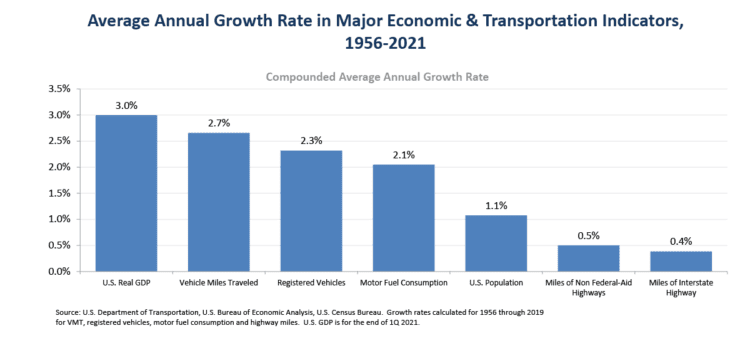America’s Economy Rides on Interstate Highways

System Turns 65 on June 29; Remains Backbone of U.S. Economy
WASHINGTON – The development of the 48,000-mile Interstate Highway System (IHS) has been a driving factor in a 340 percent growth in the nation’s gross domestic product over the past 65 years from $3 trillion to today’s $19 trillion, according to research from the Washington, D.C.-based American Road & Transportation Builders Association (ARTBA).
June 29 marks the 65th anniversary of the 1956 Federal-Aid Road Act signed by President Dwight Eisenhower that authorized the IHS and created the Highway Trust Fund (HTF) to finance its construction.
The system remains the backbone of the U.S. economy, ARTBA says. Nearly 75 percent of truck freight is carried on the Interstates.
While the IHS accounts for just 1 percent of roadway miles, it carries 26 percent of vehicle miles traveled, ARTBA Chief Economist Dr. Alison Premo Black says.
Black notes that during the past 65 years the U.S. population doubled, the number of miles traveled on the IHS increased 422 percent and the number of registered vehicles skyrocketed 324 percent.
ARTBA unearthed other facts illustrating how the IHS has helped spawn a host of industries that have transformed the U.S. economic landscape since 1956. Among them:
The Lodging Industry
The U.S. has more than 54,200 hotel properties, filling over 5 million guestrooms and generating about $168 billion in annual room revenue. Total output for this industry was $176 billion in 2020 employing 1.4 million workers.
Fast Food & Restaurant Industry
Total output in 2020 was $755.5 billion. Food and service establishments employed 10 million workers last year.
Tourism Industry
Contributes to $1.1 trillion in US GDP in 2020, with travelers in the U.S. spending $687 billion.
Convenience Store Industry
Has over 152,000 stores with sales of nearly $650 billion and over 165 million transactions each day.
At 65 and carrying traffic volumes and loads well beyond original projections, the Interstates need additional federal resources to meet 21st century economic and mobility challenges, Black says. She notes:
- More than one-third of Interstate Highway miles are over 50 years old.
- The design life for Interstate pavements in the 1950s and 1960s was 20 years.
- There are nearly 58,500 bridges on the Interstate Highway System:
- Over 18,000 (nearly one-third) need repair or replacement.
- 57 percent of the bridges are in just “fair” condition.
- Nearly half of these bridges were built in the 1950s or 1960s.
- The average age of a bridge on the IHS is 46 years old.
- Congestion on the Interstates cost over $9 billion in 2019, with truck drivers delayed by nearly 149 million hours.
Black called on Congress and the Biden administration to complete action this summer on a robust, multi-year transportation infrastructure package.
“The Interstates need a shot of investment to remain healthy and vibrant for the future,” she said. “A renewed federal commitment to America’s transportation network is one of the best ways to preserve the Eisenhower legacy and ensure the Interstates remain the engine of economic growth for decades to come.”
ARTBA, based in Washington, D.C., was organized in 1902 by a visionary Michigan public official, Horatio S. Earle, for the purpose of advocating federal legislation to create a “Capital Connecting Government Highway System.” That vision was realized when President Dwight Eisenhower signed the 1956 Interstate law. ARTBA’s members designed, built and continue to help manage the road network.


